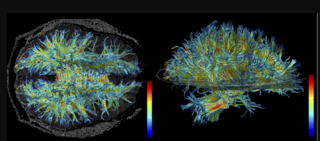Executive Function
Why Gray Matter Volume and White Matter Connectivity Matter
New research sheds light on why the human brain shrinks and loses connectivity.
Posted September 26, 2020 Reviewed by Devon Frye

Two recently published studies shed light on how specific genes are linked to a rapid loss of gray matter brain volume in the general population and how age-related decline of white matter connectivity impacts higher-order executive functioning.
What's the difference between gray matter and white matter? Gray matter (GM) consists of neuronal cell bodies that make up the bulk of neural matter in different brain regions such as the cerebral cortex (Latin for "bark") of the cerebrum. Cerebral white matter (WM) is the name given to bundles of myelinated axons that connect different gray matter structures throughout the entire brain. The myelin sheath insulates axons with a lipid-rich (fatty) substance that has a glistening white appearance. Robust WM functional connectivity and white matter integrity facilitate rapid, streamlined electrical communication between different brain regions.
The above-mentioned neuroanatomy basics related to white matter and gray matter are well established. That said, until now, neuroscientists have lacked big data related to the role that specific genes play in the loss of gray matter volume (i.e., "brain shrinkage") in various cortical regions.
This week, a team of dozens of collaborators from around the globe published a paper (Hofer et al., 2020) that identifies 160 genes linked to brain shrinkage (as indexed by a reduction in gray matter volume, surface area, and thickness) in 34 anatomically predefined cortical regions of the cerebral cortex. These findings were published on September 22 in the journal Nature Communications.
Although cortical thickness and brain volume typically decrease gradually with age, the rapid loss of gray matter and subsequent brain shrinkage is a hallmark of neurodegenerative diseases and dementia.
What makes this new (2020) study unique is that the researchers were able to make "genetic correlations and genome-wide associations" related to gray matter thickness, volume, and surface area in 34 regions of the cerebral cortex based on a large population and replicate their initial findings. The discovery group consisted of 22,824 individuals; during another phase of this study, the researchers confirmed their initial findings in a replication group of 22,635 individuals.
"This study has considerable statistical power," co-author Claudia Satizabal of The University of Texas Health Science Center at San Antonio said in a September 25 news release. "Because the results from the first sample were replicated in a second equally large sample, it is less likely that the results are purely due to chance."
"It is important to understand the biology of multiple regions of the cortex because each is affected differently in the various types of neurodegeneration including Alzheimer's disease," senior author Sudha Seshadri added. "We asked, 'What are the genes that seem to determine the thickness, area, and volume of gray matter in these regions?' [The] genes we found point to interesting pathways that seem to be involved in brain development, vascular and neurodegenerative disease, and some psychiatric conditions."

Age-Related Loss of White Matter Connectivity Affects Executive Functions
Another recently published study (Webb et al., 2020) by scientists at the University of Texas at Dallas investigated how the loss of white matter connectivity diminishes healthy brain structure and affects higher-order executive functions. These findings were published online earlier this year and will appear in the October 2020 issue of Neurobiology of Aging.
For this study, UTD neuroscientists used diffusion tensor imaging to identify how changes in frontostriatal white matter connectivity between the cerebral cortex's frontal lobes and other brain regions affected cognition at different ages. The researchers found that a loss of frontostriatal white matter connectivity was associated with poorer executive function and that this negative association tended to increase with age. As the authors explain:
"This association was moderated by age, such that younger- and middle-aged individuals showed reduced dynamic range of difficulty modulation as a function of increasing frontostriatal diffusivity. Together these results demonstrate the importance of age-related degradation of frontostriatal circuitry on executive functioning across the lifespan, and highlight the need to capture brain changes occurring in early-to middle-adulthood."
"This research shows that you don't ramp up the output of your gray matter regions as well when you're older. One reason is that the white matter connections have degraded. The electrical transmission between neurons is not as intact," senior author Kristen Kennedy, associate professor of psychology in the School of Behavioral and Brain Sciences and in UT Dallas' Center for Vital Longevity, said in a September 23 news release. "Evolving research on white matter shows that its ability to propagate signals strongly affects cognition and higher-order processing."
"More and more, research shows us that the structure of the brain affects its function, especially in terms of aging and white matter," first author Christina Webb, a research associate in the Kennedy Lab, noted. "In earlier work, we've shown this effect more broadly across white matter networks. Here, we're tying it more specifically to the frontostriatal white matter networks, which we know are linked to higher-order executive function."
Taken together, the latest research sheds light on how typical age-related decline of white matter connectivity in the frontal lobes and the heritability of "brain shrinkage" in different gray matter regions of the cerebral cortex are associated with cognitive decline and a loss of brainpower.
References
Edith Hofer, Gennady V. Roshchupkin, […] Sudha Seshadri. "Genetic Correlations and Genome-Wide Associations of Cortical Structure in General Population Samples of 22,824 Adults." Nature Communications (First published: September 22, 2020) DOI: 10.1038/s41467-020-18367-y
Christina E. Webb, David A. Hoagey, Karen M. Rodrigue, Kristen M. Kennedy. "Frontostriatal White Matter Connectivity: Age Differences and Associations With Cognition and BOLD Modulation." Neurobiology of Aging (First published online: June 07, 2020) DOI: 10.1016/j.neurobiolaging.2020.05.014




